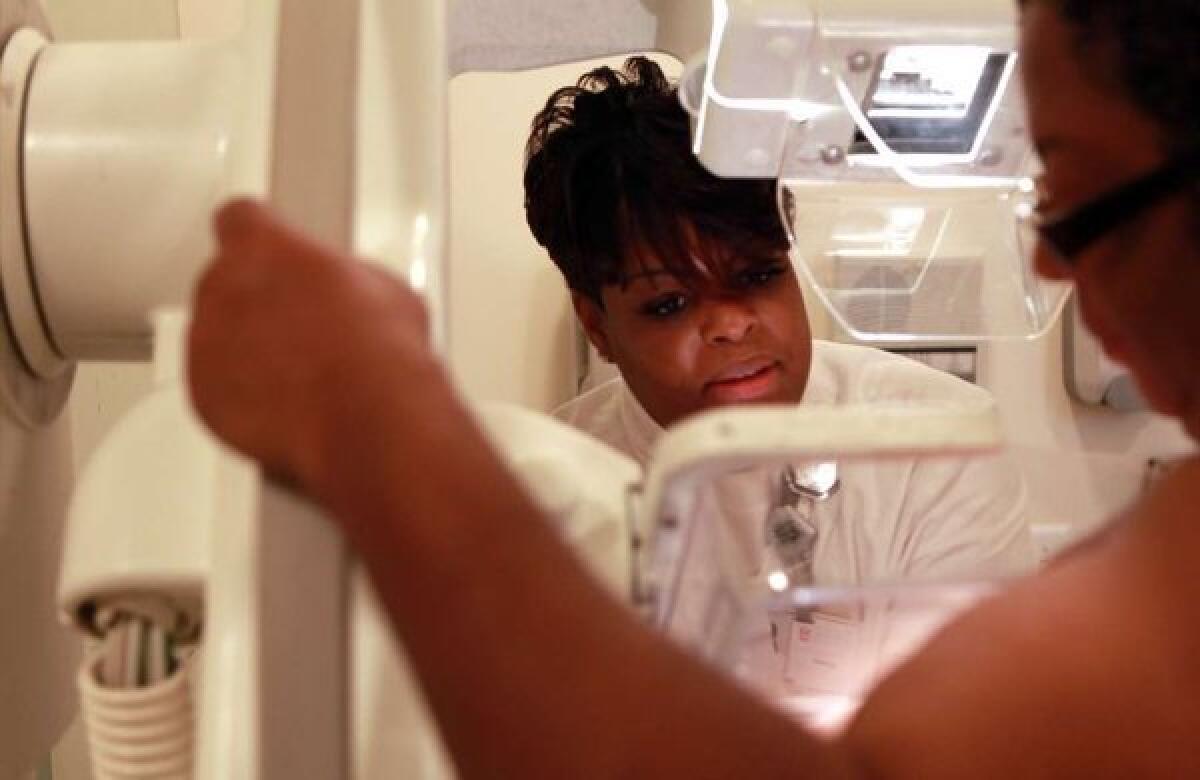Risk models tested to predict breast, ovarian, endometrial cancers

- Share via
Women, wouldn’t you like to know your precise risk of developing breast cancer, ovarian cancer and endometrial cancer? And wouldn’t you like to know what changes you could make in your life to reduce that risk?
Researchers from the National Cancer Institute would like to help you. They’ve just published a study in the journal PLOS Medicine that takes a significant step toward that goal.
Ruth Pfeiffer, a senior investigator in the National Cancer Institute’s Division of Cancer Epidemiology and Genetics, and colleagues focused on the predictive value of more than a dozen variables, including a woman’s body mass index, number of children she has, how long she took birth control pills, whether she used hormone therapy to treat symptoms of menopause, family history of gynecological cancers, and use of cigarettes and alcohol. They examined those variables in tens of thousands of women who participated in two long-term health studies — the National Institutes of Health-AARP Diet and Health Study and the Prostate, Lung, Colorectal, and Ovarian Cancer Screening Trial — and used statistics to look for patterns that could explain why some women were diagnosed with cancer and others were not.
The breast cancer model performed the best. Among a group of 56,638 women who were part of the Nurses’ Health Study, the researchers predicted a total of 2,930 breast cancer cases. In real life, there were 2,934. That was slightly more accurate than the NCI’s Breast Cancer Risk Assessment Tool, which forecast a total of 2,947 breast cancer diagnoses. However, although the new model got the total number almost exactly right, it “significantly underestimated the number of breast cancers in premenopausal women,” the study noted.
The model for ovarian cancer worked pretty well too. It predicted 406 cases, about 8% higher than the 377 cases that were actually diagnosed.
The model for endometrial cancer was further off the mark. It anticipated 640 cases among the nurses, though in real life there were only 532 cases. However, the research team noted that theirs was the first published model to predict an absolute risk for endometrial cancer, which is the fourth most common cancer in women.
Science and Health: Sign up for our email newsletter
Need some motivation to lose weight or quit smoking? Generally speaking, women with lower BMIs had lower cancer risk.
Other variables were linked to cancer risk, but you’d need a time machine to change them. For instance, women who took birth control pills tended to have higher cancer risk than women who didn’t. So did women who used hormone replacement therapy. Women who had three or four children tended to have lower cancer risk than women who had one, and it helped if they had their first child in their 20s instead of in their 30s or 40s.
The researchers noted some important caveats. All of the women used to develop the models were white and at least 50 years old, and none of them had mutations in their BRCA1 and BRCA2 genes that are known to boost the risk of breast or ovarian cancer. That means the results wouldn’t necessarily apply to all women, they wrote.
In theory, reliable models could help women make important decisions about their health, especially in cases where a certain action decreases the risk of one type of cancer but raises it for another. Here’s an example Pfeiffer and her colleagues described in the study: A woman with a high risk of breast cancer might consider taking tamoxifen to reduce that risk. But first, she might like to know her risk of endometrial cancer, since the drug would increase her risk for that.
In a Perspective essay that accompanied the PLOS Medicine study, two experts praised the idea of developing models to predict cancer risk. “What we want from models is that they help us make better decisions, leading to better outcomes for our patients,” they wrote. But the jury is still out on the best way to judge any model’s strengths and weaknesses, they added.
Return to Science Now.
[For the record, 6:18 p.m. Aug. 2: A previous version of this story incorrectly stated that among women with similar BMIs, smokers had a higher cancer risk than nonsmokers. In fact, as expected, smoking had no effect on risk for breast or ovarian cancer. However, for endometrial cancer, nonsmokers had higher risk than smokers. This relationship has been observed in previous epidemiologic studies.]




